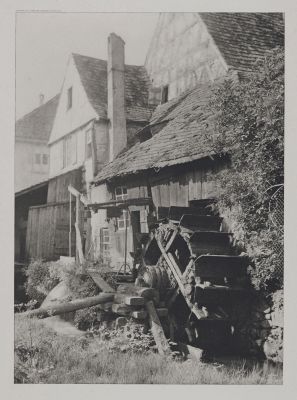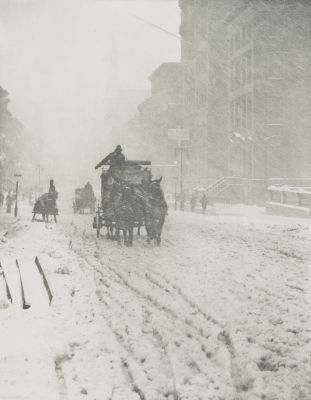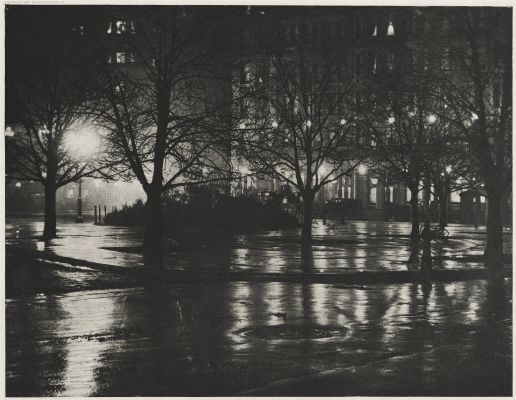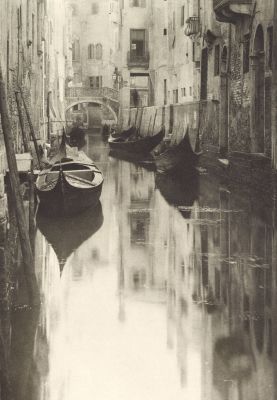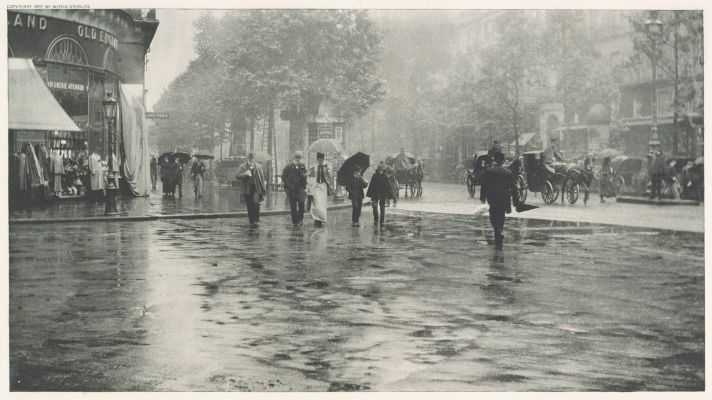
Title
On the Seine – Near ParisArtist
Stieglitz, Alfred (American, 1864-1946)Key FigurePublication
Picturesque Bits of New York and Other StudiesDate
1897 plate (1894 negative)Process
PhotogravureAtelier
Alfred Stieglitz (film positive)Image Size
16.8 x 26.7 cmSheet Size
35.5 x 43 cm
"On the Seine, a double road on the embankment of the river, with a row of trees in the middle, loses itself in an obtuse angle in the distance. A flock of goats has grouped itself in the road nearest to the river. To the right a vista on the Seine, a tug boat with a line of barges, and a silhouette of the housetops of Paris in the distance. It is a decorative panel filled with the musical cadence of a waning day, and that peculiar atmosphere which roads where city and country blend together always have for me. What patience the artist must have exercised before the goats grouped themselves so adequately! In fact Mr. Stieglitz told me that for more than a week he stood every afternoon at dusk with his camera at the same spot, until at last he saw before him what he considered essential for a picture. The cluster of dark foliage, the border of grass along the edge of the water, and the distance have lost in values through the reproduction, but otherwise it is a picture which any modern master could be proud of. It is a well balanced artistic composition of rare decorative suggestiveness which shows that the artist understands the charm and power of linear and spacial beauty. “On the Seine” is a tribute to the undeniable truth that the future of art lies largely in decoration." (Murray)
A landmark in photogravure and photography as fine art.
It was during Stiegitz’s years as editor of Camera Notes that he began exploring the artistic possibilities of photogravure. In 1897, the very year that Camera Notes commenced, the prestigious publisher R. H. Russell issued Picturesque Bits of New York and Other Stories, a portfolio of twelve of Stieglitz’s best-known early images printed as oversized photogravures. So important was this project to Stieglitz, that he personally made the transparencies used in plate making, and then supervised the printing of the entire edition of photogravures. So pleased was he with the results that he signed a limited deluxe edition of the portfolio and allowed the photogravures to be sold individually. Stieglitz felt these prints had high-art value and were no less intrinsically works of art because they were printed by photogravure. Such photogravures joined the great tradition of fine printmaking established by artists like Durer and Rembrandt. [1]
We have been accustomed to see the fine tones and graduations of our best workers so utterly ruined in the process of engraving and printing that we are agreeably surprised at the wonderful delicacy and transparency of these examples. They are printed on heavy plate paper, 14×17 inches, and each plate is presented in a color appropriate to the subject. We might take exception to the tint employed in the “Glow of Night,” where the desire to reproduce the yellow glare of the incandescent and other lights glowing through the fog and mist of a rainy night on Fifth Avenue has led to the employment of colors that are singularly disagreeable. Perhaps our photographic experience heightens this repugnance, because the tones, ranging from yellow to a somewhat dirty greenish black, recall the effect of an aristotype badly sulphurized in a combined toning and fixing bath. It is possible that the print will be more satisfactory to an artist, or to an art lover, who has never dabbled in photography. In all the other cases the colors are admirably chosen. [2]
The photogravures were printed in an edition of twenty-five on plate paper using different ink colors. Stieglitz himself made the steel engravings from the diapositives (positives made from negatives) and used rapid plates to preserve the detail and softness of the originals. In addition, he directly supervised the printing of each image. Picturesque New York was apparently an earlier title of the portfolio. [3]
The pictures vibrate with atmosphere–fog, snow, streetlights reflected on wet pavements. The word “bits” suggests fleeting impressions caught by a highly selective eye, the crystallization of experience similar to the effects sought by Ezra Pound and Hilda Doolittle in the Imagistic poetry they would invent in the next decade. [4]
A two-page advertisement for the portfolio appeared in a small catalogue issued by publisher RH Russell in 1897 stating specifics for the portfolio as well as photographs, which Stieglitz sold individually. The twelve subjects, together with an introduction by W.E. Woodbury, are issued in an artistic portfolio. Price, $10.00 There will also be an Edition-De-Luxe in a special binding, limited to forty copies of the first impressions, each plate signed by Mr. Stieglitz. Price, $25.00 Single Proofs of any of the plates. Price, $2.00, each. Artist’s Proofs, signed by Mr. Stieglitz. Price, $5.00, each.
Even with this marketing push by RH Russell as well as others, it is doubtful that many of the Picturesque Bits portfolios were sold, especially the $25.00 Edition-De-Luxe edition signed by Stieglitz. Book seller catalogues around the turn of the 20th century remaindered original $10.00 “ordinary” copies of the portfolio to $5.00. The now accepted total copies of this seminal portfolio in the history of photography numbers a mere 25 copies: “The photogravures were printed in an edition of twenty-five on plate paper using different ink colors.” [5]
Reproduced / Exhibited
Thornton, Gene. Masters of the Camera: Stieglitz, Steichen & Their Successors. New York: Ridge Press, 1976 42
Greenough, Sarah, and Alfred Stieglitz. Alfred Stieglitz: The Key Set : the Alfred Stieglitz Collection of Photographs. Washington, D.C: National Gallery of Art, 2002. Pl 120
Hoffman, Katherine. Stieglitz: A Beginning Light. New Haven: Yale University Press, 2004. no. 118
Frank, Waldo D. America and Alfred Stieglitz: A Collective Portrait. New York: Aperture, 1979. pl. 32
References
[1] Peterson Christian A et al. Alfred Stieglitz’s Camera Notes. 1st ed. Published by the Minneapolis Institute of Arts in Association with W.W. Norton 1993.
[2] William M. Murray, “Reviews and Exchanges: ‘Picturesque Bits of New York, and Other Studies,’” Camera Notes 1 (January 1898), 84–85.
[3] Lunn Photo-Secession: Catalogue 6 [exh. cat., Lunn Gallery, Graphics International Ltd.] (Washington, 1977), 124–125.
[4] Trachtenberg, Alan; Reading American photographs: Images as History: Mathew Brady to Walker Evans: 1989: Hill and Wang: New York: p. 184
[5] https://www.nga.gov/research/online-editions/alfred-stieglitz-key-set/portfolios-and-published-photographs.html
Alfred Stieglitz | The Key Set: The Alfred Stieglitz Collection of Photographs: Volume Two 1923-1937: Sarah Greenough: National Gallery of Art, Washington| Harry N. Abrams, Inc. : 2002: p. 937
https://photoseed.com/collection/group/picturesque-bits-of-new-york-and-other-studies/ (cited Oct. 11, 2022)
